Changes in the Rhythm of the Industry Ecosystem: From "Fast" to "Steady"
The development trajectory of the Web 3 industry is undergoing a profound shift in rhythm.
In the early days, narrative-driven speculation constituted the main theme of the crypto ecosystem. Bitcoin halving, DeFi Summer, NFT frenzy—these stories once attracted a massive influx of funds and attention in a short period, accelerating the construction of infrastructure. However, the rapid pace also brought concerns: over-reliance on financing and neglect of long-term implementation led to many projects being short-lived.
The paradox of fast-paced growth is that it indeed spurred innovation, but it also drained the patience of users and capital. As the industry entered a cooling period from 2022 to 2023, the speculative bubble gradually faded, and market sentiment became more rational. This is not a retreat but a transition into a phase of genuine internalized growth.
According to CoinMarketCap data, mainstream coins like Bitcoin and Ethereum have re-established their dominance: Bitcoin's market cap share fell to about 39% in 2022, but the average for 2023 rose to 45.6%, further increasing to 51.9% in 2024, and as of 2025, it has approached 59.3%. This indicates that after the baptism of the last bear market, funds are increasingly flowing towards leading assets like Bitcoin and Ethereum.
In contrast, long-tail altcoins and Memecoins have stirred up some waves locally, but overall growth has been weak. For example, the Memecoin craze sparked by Pepe in the second quarter of 2023 saw Pepecoin's market cap soar to about $1.5 billion by the end of 2024, but it quickly fell back below $700 million; the meme launch platform pumpfun briefly outperformed Tier 2 exchanges in platform fee revenue, but as market rationality returned, current fees have dropped to a maximum of 5% of their peak.
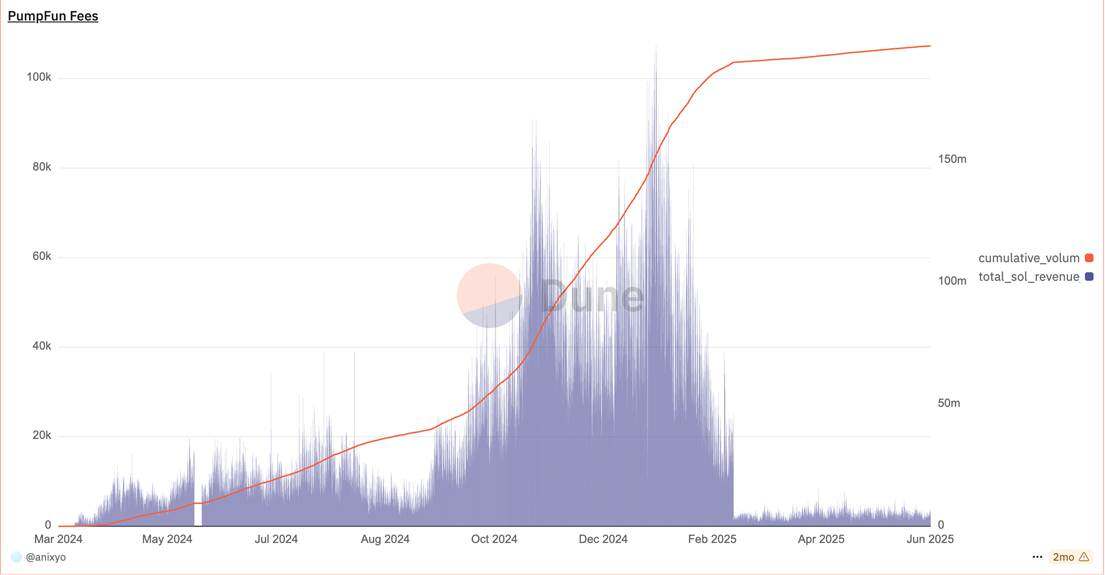
(Red line: cumulative trading volume of pumpfun; blue bars: pumpfun's daily fees; source: Dune)
These meme coins, which lack fundamental support, often "bloom briefly" and struggle to retain market value in the long term. In contrast, crypto assets like Bitcoin and Ethereum, which possess network effects and application ecosystems, have shown more robust performance in this round of recovery, with their market cap growth and share increase significantly outpacing the vast majority of long-tail projects.
The reduction in investors' risk appetite and the return to value have accelerated the concentration of market funds towards the top assets, sending a clear market signal: speculative projects are increasingly difficult to sustain in the long term, and funds are concentrating back to leading assets.
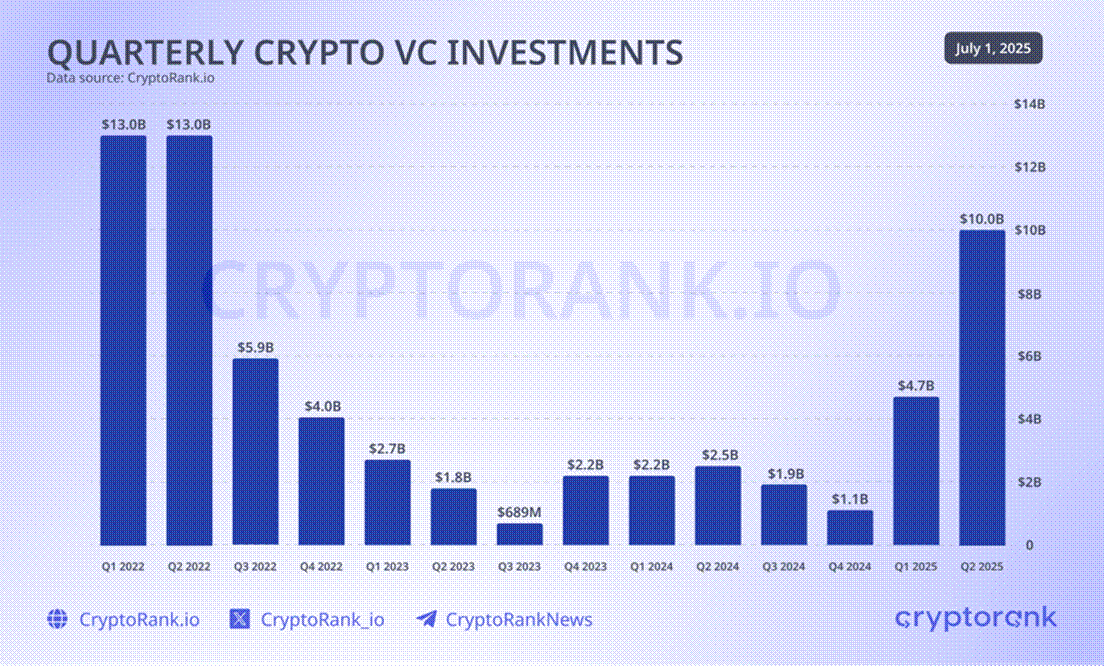
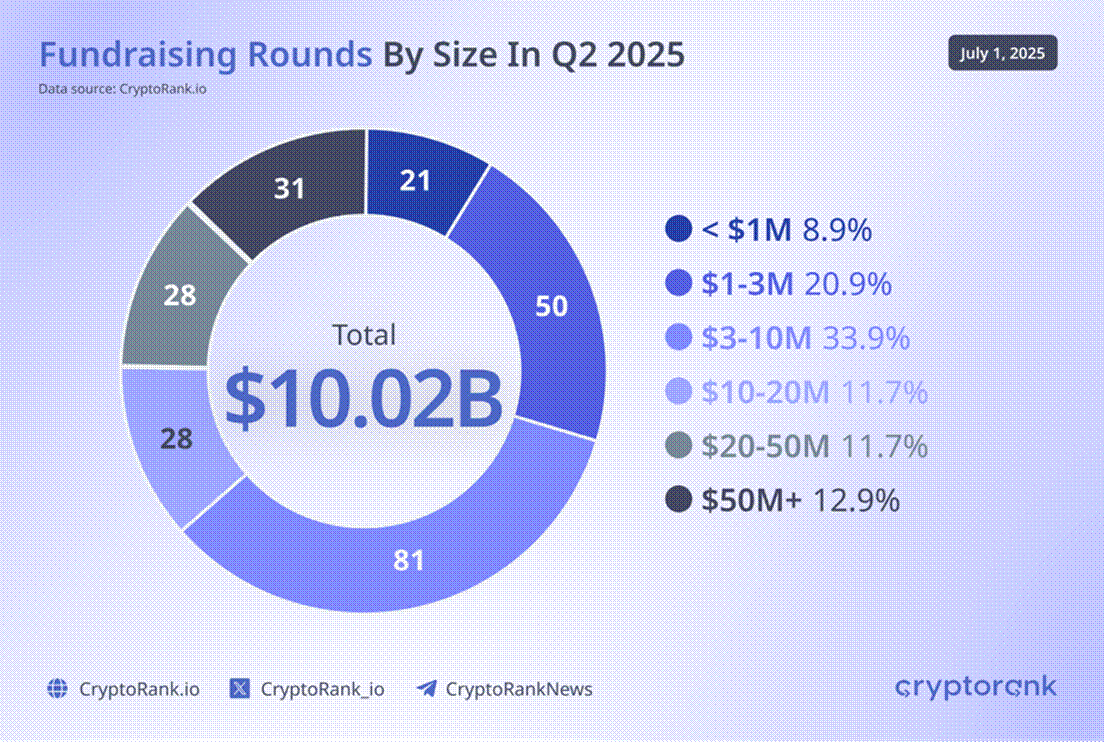
(Source: crypto rank)
The logic of VC investment has also changed. In 2022, venture capital fundraising in the industry peaked, but it suddenly shrank in 2023. As we enter 2024-2025, funds are warming up but with a different focus: investors prefer platforms with solid team backgrounds, MVPs that are operational, and cash flow models, rather than early experimental projects driven by narratives.
In the face of the focus and shrinkage of primary market investment opportunities, industrial capital is turning its attention to secondary markets and public market opportunities.
On one hand, traditional VCs are becoming increasingly cautious about investing in early crypto projects; on the other hand, large institutional funds are beginning to position themselves by investing in publicly traded crypto assets. For example, the crypto investment firm Pantera recently invested $300 million specifically in companies adopting the "Digital Asset Treasury (DAT)" model, betting that these publicly listed companies incorporating crypto assets into their financial reports can achieve better returns than direct holdings or ETFs.
These DAT companies issue stocks in the public market to raise funds, using the proceeds to hold large amounts of Bitcoin, Ethereum, etc., and participate in staking yields, thereby achieving growth in net asset value per share. This innovative model has quickly attracted Wall Street's attention—reports indicate that several crypto asset treasury companies have raised billions of dollars, with stock prices soaring, drawing legendary investors like Stan Druckenmiller, Bill Miller, and ARK funds into the fray.
The valuation paradigm of traditional capital markets is thus influencing and reshaping the native Web 3 rules. Although these companies are labeled as "crypto concepts," they actually operate according to traditional business standards: pricing based on balance sheets and cash flows, emphasizing net asset value per share, discounted earnings, and other fundamentals. For instance, MicroStrategy (now renamed "Strategy") has purchased large amounts of Bitcoin since 2020, with its stock performance linked to Bitcoin prices, being viewed as a "quasi-Bitcoin ETF"; new generation DAT model companies like BitMine Immersion have gone further, boldly financing Ethereum holdings through equity and convertible bonds, and using staking and DeFi strategies to enhance asset yields.
This signifies that the Web 3 ecosystem is constructing a "Maslow-style hierarchy of needs" shift: from high-risk ventures to basic needs of safety, payment, and trust.
The past Web 3 was filled with speculation and speed, but now, as funding and narratives cool down, the industry is shifting towards a more robust construction phase. The increase in Bitcoin and Ethereum's market cap share, the change in VC investment logic, the advancement of policy regulation, and the rise of new asset operation models like "DAT" are all signals of the arrival of the "BenFen" era.
Global Participants are "BenFen-izing": A Sign of Industry Maturity
If the "rhythm change" is the external manifestation of the industry, then "BenFen-ization" is a deeper internal logic. "BenFen" refers to different roles returning to constructive and sustainable development paths.
The evolution of the policy environment is shaping new industry boundaries. The U.S. GENIUS Act, the EU's MiCA, and Hong Kong's stablecoin licensing system, while differing in details, share a clear consensus: protecting investors, enhancing transparency, and opening channels for compliant funds to enter. For project parties, this means that "gray area" businesses will become increasingly difficult, and compliance and transparency will become mandatory thresholds.
• United States: The "Stablecoin Innovation and Protection Act" (GENIUS Act) requires stablecoin issuers to 100% back their coins with highly liquid assets (USD, short-term U.S. Treasury bonds, etc.) and mandates issuers to publicly disclose reserve compositions monthly to ensure stablecoins are "true to their name."
• European Union: The "Markets in Crypto-Assets Regulation" (MiCA) stipulates that crypto asset service providers (CASPs) must obtain licenses and meet capital requirements, bearing legal responsibility for client asset losses; stablecoin issuers must maintain a 1:1 reserve and disclose regularly, with large stablecoins subject to oversight by the European Central Bank and the European Banking Authority (EBA).

From search trends, if "DeFi," "NFT," and "yield farming" were high-frequency keywords in the blockchain field in 2021, then from 2024 to 2025, the main focus of search popularity has quietly shifted to "stablecoins," "compliance," and "cross-border payment."
Especially with the implementation of the EU's MiCA and the signing of the U.S. GENIUS Act, Google Trends also shows that global searches for "stablecoins" surged to historical highs during regulatory favorable moments (such as the effectiveness of MiCA and the signing of the U.S. GENIUS Act).
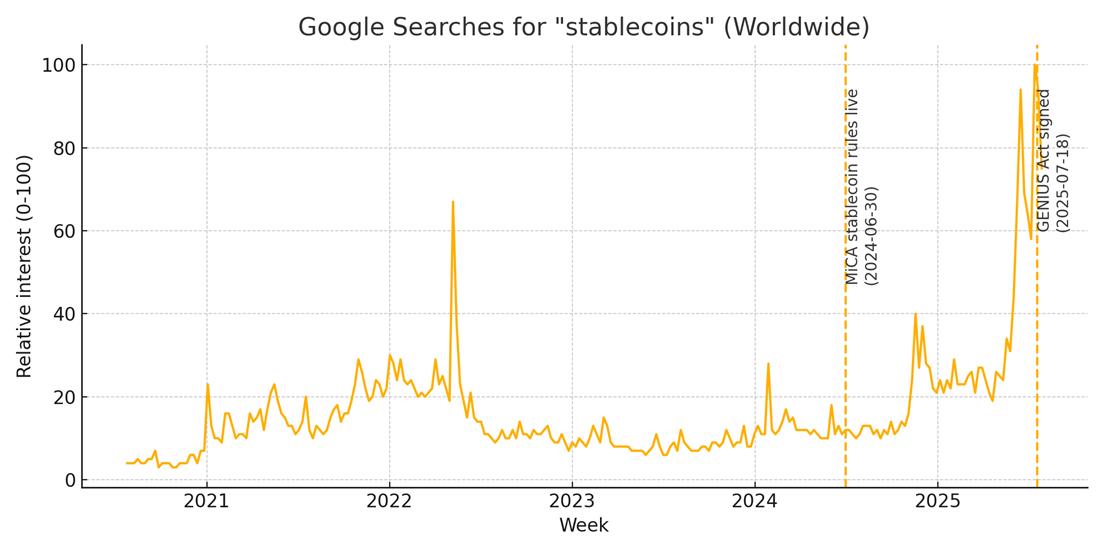
Google stablecoin search (Source: Google Trends)
These data indicate that while industry growth no longer exhibits the explosive frenzy of the early days, it is steadily recovering, with sustainable growth. The evolution of keywords clearly shows the industry's trajectory from speculative narratives to stability and application scenarios, with blockchain technology becoming the foundational infrastructure for payment scenarios.
In this trend, the capital market is also seeking more robust entry methods. ETFs are one path to bring traditional funds into the crypto space, and the recent surge in BitMine's stock price has proven the effectiveness of the DAT strategy: issuing stocks at a premium to acquire crypto assets, cashing out on volatile returns through convertible bonds, and obtaining staking and DeFi interest, ultimately feeding back into net asset value per share.
Its successful demonstration indicates that applying traditional DCF valuation models to crypto asset operations is feasible: the market is beginning to price these companies based on their per-share asset appreciation capabilities rather than merely on the conceptual premium of crypto assets. This trend is already reflected in the finances of traditional enterprises and listed companies: an increasing number of institutions are no longer just observing but are directly incorporating Bitcoin and Ethereum into their balance sheets.
Currently, the number of Bitcoin and Ethereum held on the balance sheets of listed companies and institutions is reaching new highs. As of the second quarter of 2025, over 100 listed companies globally hold Bitcoin on their balance sheets, collectively holding about 1 million BTC (approximately 4.7% of Bitcoin's total supply, valued at about $110 billion); in terms of Ethereum, statistics show that 11 institutions collectively hold nearly 2.98 million ETH (about 2.5% of Ethereum's supply, valued at about $13.8 billion). These data indicate that traditional funds are accelerating their entry into the crypto asset market through ETFs and the financial allocations of listed companies.
The advancement of legislation provides a protective umbrella for investors and paves a broad avenue for sovereign funds, the finance departments of listed companies, and other long-term capital to enter. As a large amount of compliant capital flows in, the game rules of the crypto industry increasingly align with those of traditional capital markets—transparency, compliance, and intrinsic value will become the focal points of market attention, making large-scale widespread application more likely. As capital logic gradually becomes institutionalized, the industry's focus shifts from speculation to construction.
The essence of this trend is that Web 3 is entering the "Builder Era." The value of trust and order is replacing short-term profit-seeking as the core. The regulations and rules of medieval guilds once provided a foundation of trust for commerce; today, stablecoins and compliance frameworks serve as the "daily necessities" of digital finance, and the value of these "daily necessities" is directly reflected in stablecoin data.

(Image source: Internet, please delete if infringing)
The Explosive Growth of Stablecoin Data Indicates a Reshaping of the Landscape
According to Artemis data, the global monthly settlement amount of stablecoins in December 2024 is approximately $5.1 trillion, three times that of the same period in 2023 and 22 times that of 2021; VanEck states that the current daily settlement scale of stablecoins has reached around $100 billion, gradually approaching the scale of traditional cross-border payment networks like SWIFT.
The on-chain transaction structure has also changed. According to Chainalysis data, stablecoin transaction volume accounts for 50%–75% of the total on-chain transaction volume, making it the most important asset class on-chain.
This is why we have invested in and incubated the public chain BenFen, which natively supports stablecoin payment for Gas, one-click token issuance, and on-chain merchant payment interfaces—because this is the most fundamental part of future demand.
Market Performance Shifts from "High Volatility" to "Steady Growth"
According to Bloomberg, from 2024 to 2025, the volatility of Bitcoin and Ethereum prices has significantly decreased, with Bitcoin's two-year implied volatility dropping to a two-year low; according to Coindesk, compliant stablecoin ecosystems like Circle (USDC) have rapidly expanded following favorable policies, with their stock prices skyrocketing more than tenfold after the new regulations were announced. The flow of funds has also become more rational: some crypto capital is moving away from high-risk stocks towards digital assets like Bitcoin and stablecoins as a "hedging" allocation.
Further analysis by McKinsey indicates that blockchain + stablecoin payments can reduce the traditional cross-border payment settlement cycle from 2–3 days to seconds, greatly improving the payment experience. This change is reflected not only in market data but also in the shift in user demand.
In 2021, users were chasing wealth myths and excitement—a form of radical adventure that was almost "self-fulfilling": high-yield DeFi pools, NFT breakout myths, and overnight wealth from GameFi. This emotional overlay shaped a crypto narrative colored by desire and speculation.
By 2025, this demand has quietly shifted towards "basic functionalities": the convenience of payments, the security of assets, and the certainty of compliance. This transformation coincides with the implementation of regulations, the entry of institutions, and the maturity of infrastructure. In McKinsey's words, "the significance of blockchain + stablecoin payments is not speculation, but reducing cross-border payments from 2–3 days to a few seconds."
This also raises a deeper question: in a context where risk control and stability are increasingly important, what is the true foundation of digital currency? Is it speculative enthusiasm, or is it a sense of "order" that is widely accepted and can be used in daily life? Perhaps when cryptocurrencies are reinterpreted as financial tools for "daily necessities" rather than tickets to overnight wealth, they will truly mature.
This resonates with the change in user demand: if in 2021 crypto users were chasing wealth myths and high-risk gambles, by 2025, users are more focused on payment convenience, asset hedging, and compliance safety. In other words, digital currency is returning from "radical adventure" to "basic functionality," from satisfying curiosity to satisfying a sense of security.
This shift may resemble a "rite of passage" for the industry: bidding farewell to wild growth and entering a period of institutionalization and steady growth.

The Path for Projects: Returning to Product and Operations, with Rising Barriers to Success
In the current environment of tightening regulations and shifting capital preferences, the biggest dilemma for project teams is the failure of old paths: it is increasingly difficult to easily finance through "token issuance + narratives." The new path to survival is to benchmark against traditional internet giants and return to product and operations. Success is no longer about luck but a competition of comprehensive strength.
First, the choice of track and matching user needs have become key to success or failure. Just as Meituan focuses on local life services and ByteDance delves into content socialization, rising through excellent execution in their respective fields, Web 3 startups also need to identify niche markets and consistently provide excellent products.
For example, Ethereum has continuously upgraded its network capabilities over the years in the smart contract platform track (from PoW to PoS, advancing sharding, etc.), attracting a large number of developers and users, ultimately solidifying its unshakeable ecological position. In contrast, many so-called "Ethereum killers" projects, while temporarily achieving high valuations, have seen their popularity quickly fade due to a lack of sustained technological breakthroughs and user scenario expansion.
Similarly, in the decentralized finance (DeFi) sector, Uniswap initially met users' urgent need for on-chain exchanges and maintained its competitive advantage through continuous algorithm improvements (upgrading to V3/V4 protocols, etc.), with its market share far exceeding later imitators. These cases indicate that projects without long-term product-market fit (PMF) will ultimately be eliminated by the market.
Secondly, user experience (UX) and the improvement of infrastructure have become crucial. Web 3 products often involve complex concepts like private key management and Gas fees, which have been barriers to mass adoption by ordinary users. However, the industry has recently seen many explorations to improve UX, such as smart contract wallets, account abstraction, and off-chain transaction acceleration, aimed at making blockchain interaction experiences approach the convenience of Web 2 applications.
Teams that prioritize UX are undoubtedly more likely to capture mainstream users. For instance, hyperliquid, which has gained immense popularity in this bull market, has UX designed specifically for trading, firmly grasping the user habits of market-making teams and asset management teams, creating product stickiness accordingly. Therefore, project teams need to focus on users in product development, just like internet companies, to stand out in a crowded market.

(Image source: Internet, please delete if infringing)
Finally, and most importantly, the comprehensive threshold for Web 3 entrepreneurship has significantly increased; funding, teams, management, and strategic direction are all indispensable. In the past, a small development team of two or three people could raise hundreds of millions of dollars with just an idea, but now investors are more rational, and users are more discerning.
Entrepreneurial teams need to have sufficient financial reserves to endure the long R&D and customer acquisition cycles, as blockchain infrastructure and ecosystem cultivation often take longer and cost more than traditional internet; they also need to attract top talent to build a strong team, including both blockchain foundational technology developers and diverse talents who understand product design and market operations; at the same time, a scientific management and governance structure is crucial—many decentralized projects lack proper governance, leading to inefficient internal decision-making and ultimately missing opportunities; conversely, some projects have made their team operations more stable and efficient through dual governance structures of foundations + communities and by bringing in experienced operational executives.
Lastly, a visionary helmsman is needed to grasp a clear strategic direction and adjust the course in a timely manner amidst industry waves. As an accelerator mentor once said: "Fast-profit meme coin projects lack sustained value; entrepreneurs should focus on long-term visions and solve real problems, rather than chasing fleeting trends." Only under the premise of correct direction, continuously iterating and optimizing business based on market feedback, can projects expand their user base and revenue sources, entering a virtuous cycle.
Overall, as the Web 3 industry matures, entrepreneurship has returned to the essence of business: there are no longer shortcuts for "overtaking on curves"; success requires patiently refining products, continuously operating communities, adhering to compliance requirements, and integrating various resources.
In this process, entrepreneurial teams that can benchmark against traditional giants—possessing both innovative passion and pragmatic style along with operational wisdom—are likely to emerge victorious in increasingly fierce competition and capture a significant market share. Today, the threshold for entrepreneurial success has significantly increased compared to a few years ago: this is both a challenge and a sign of the industry's maturation.
The Web 3 enterprises that truly stand out in the future may simultaneously possess the robust operational capabilities of traditional internet giants and the innovative tension brought by blockchain technology, writing their own legends in the new digital economic landscape.
Why We Named Our Incubated Project BenFen
In the noisy and volatile industry cycle, Bixin Ventures has been seeking infrastructure opportunities that can transcend cycles.

We clearly see that as speculative narratives recede, stablecoin payments and compliant applications that align with real use cases are becoming the core increment of Web 3. What is truly lacking is not new coins, but a foundational system that can accommodate all stablecoins and support real transactions.
"BenFen," in the Chinese context, means being grounded, responsible, and long-term oriented. It is a summary of our long-term investment logic in this industry: not chasing trends, but solidifying the foundation.
This is also the reason we are incubating the BenFen public chain.
Why BenFen
As a long-term strategic project incubated by the Bixin team, BenFen is different from other chains in the market; its mission has been very clear from day one: to be the chain for the next generation of stablecoins.
We have three reasons for choosing to invest in and promote BenFen:
Trend Judgment: Stablecoins are transitioning from "exchange assets" to "payment and settlement assets," and the industry needs a public chain born for stablecoins.
Team Background: The core team has deeply engaged in blockchain for ten years, experiencing multiple bull and bear markets, and possesses cross-disciplinary collaboration capabilities in technology, financial management, and compliance understanding.
Long-term Path: BenFen does not chase short-term hotspots and coin prices, but gradually builds an ecosystem around real scenarios such as payments, cross-border settlements, and RWA.
Specific Practical Directions of the BenFen Approach
Concepts must be implemented in practice. The technology and product path of the BenFen chain is designed around "long-term infrastructure capabilities," building a robust, universal, and sustainable on-chain financial foundation.
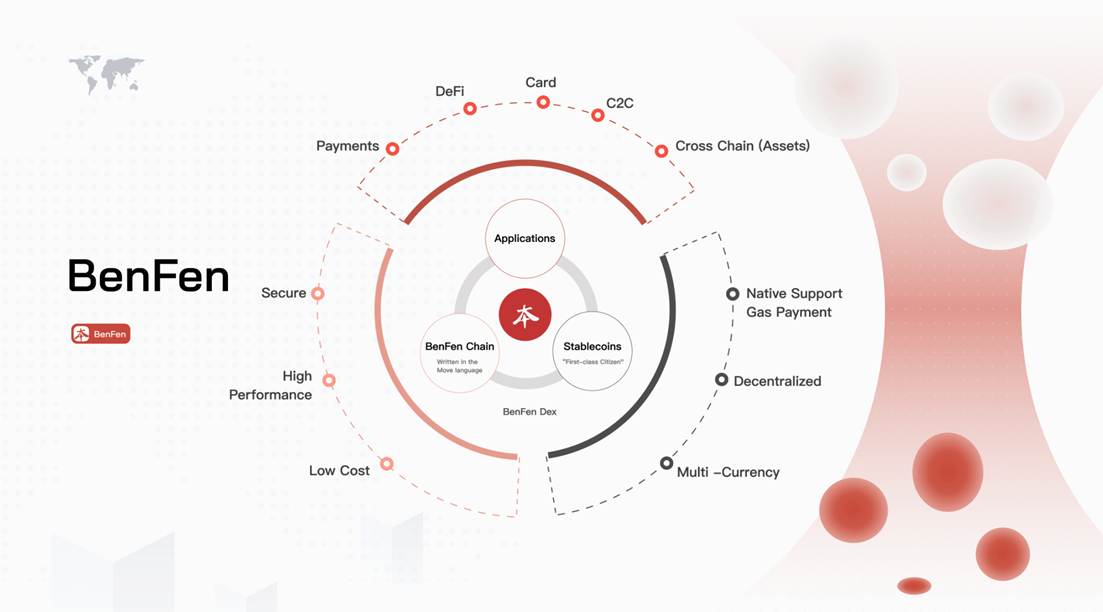
• High-performance Execution Environment: Sub-second confirmation speed and tens of thousands of TPS support high-frequency scenarios such as payments and transactions.
• Stablecoins at the Core: We believe stablecoins are the most sustainable interface between Web 3 and the real world, serving as the foundational asset for the reconstruction of global payment and financial order.
• One-click Issuance Mechanism: Supports low-threshold smart contract issuance for ordinary tokens, stablecoins, and RWAs, lowering the barriers for entrepreneurs and builders.
• Stablecoin Payment for Gas: Stablecoins can be used to pay for Gas, lowering the usage threshold and optimizing the on-chain user experience.
• Native Gas-Free Support (Sponsored Transaction Mechanism): On-chain transaction fees are sponsored by third parties, allowing users to complete transfers, exchanges, and other operations without holding native tokens, significantly reducing the usage threshold for Web 3 applications.
• Native Cross-Chain Bridge + Oracles + DEX: The BenFen chain natively integrates three major modules: cross-chain protocols, oracles, and decentralized exchanges (DEX), building an integrated decentralized financial infrastructure. The cross-chain bridge supports the flow of multi-chain assets, enhancing inter-chain liquidity; oracles provide verifiable off-chain data on-chain, ensuring reliable pricing for key scenarios such as RWA and exchange rates; the DEX module (BenPay DEX) provides on-chain liquidity support for stablecoin and mainstream asset exchanges, serving practical needs such as payments, lending, and asset allocation.
• Native Privacy Payment Support: Exploring the integration of privacy technologies such as zero-knowledge proofs, supporting the protection of transaction amounts and recipient privacy during on-chain payment processes, providing censorship resistance and financial anonymity while ensuring compliance.
• One-Click Login System for Social Accounts: Based on zkLogin, users can create wallets with their Google/Apple accounts in one click, achieving an on-chain experience without plugins or mnemonic phrases.
These capabilities collectively form the core advantages of BenFen: not creating short-term increments, but gradually building long-term capabilities that transcend cycles, continuously and stably providing a long-term usable foundation for the application of stablecoins in lifestyle scenarios.
Bixin Ventures' Choice
As investors and incubators, we are well aware that the noise in the industry has not completely subsided, but the future order is already clear: only by being grounded can we move towards sustainability.
BenFen chooses to spend time on research, refinement, and construction rather than chasing fleeting trends. Perhaps this path will not be the fastest, but it will certainly go the farthest.
For Bixin Ventures, BenFen is not just a public chain; it is our judgment and investment answer for the industry in the next decade.
Official website: https://www.benfen.org/
免责声明:本文章仅代表作者个人观点,不代表本平台的立场和观点。本文章仅供信息分享,不构成对任何人的任何投资建议。用户与作者之间的任何争议,与本平台无关。如网页中刊载的文章或图片涉及侵权,请提供相关的权利证明和身份证明发送邮件到support@aicoin.com,本平台相关工作人员将会进行核查。




